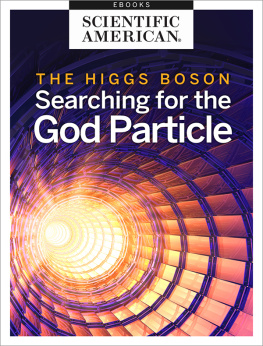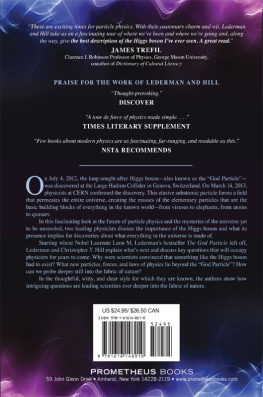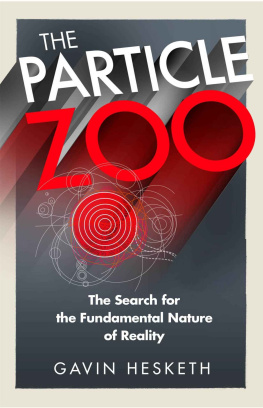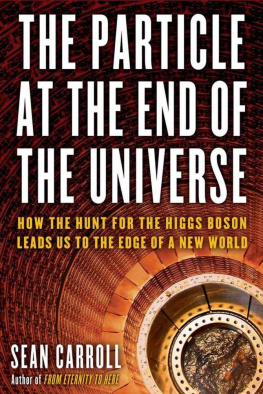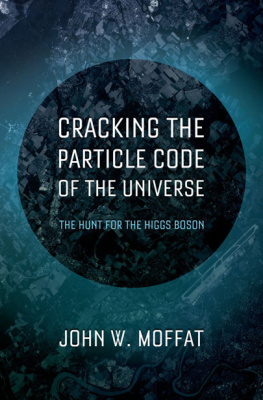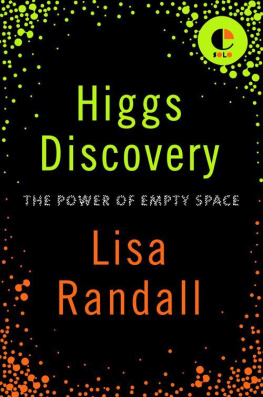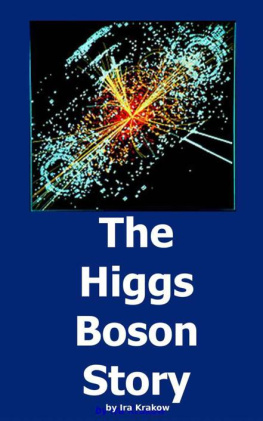Ivo van Vulpen - How to Find a Higgs Boson-and Other Big Mysteries in the World of the Very Small
Here you can read online Ivo van Vulpen - How to Find a Higgs Boson-and Other Big Mysteries in the World of the Very Small full text of the book (entire story) in english for free. Download pdf and epub, get meaning, cover and reviews about this ebook. year: 2020, genre: Romance novel. Description of the work, (preface) as well as reviews are available. Best literature library LitArk.com created for fans of good reading and offers a wide selection of genres:
Romance novel
Science fiction
Adventure
Detective
Science
History
Home and family
Prose
Art
Politics
Computer
Non-fiction
Religion
Business
Children
Humor
Choose a favorite category and find really read worthwhile books. Enjoy immersion in the world of imagination, feel the emotions of the characters or learn something new for yourself, make an fascinating discovery.

- Book:How to Find a Higgs Boson-and Other Big Mysteries in the World of the Very Small
- Author:
- Genre:
- Year:2020
- Rating:3 / 5
- Favourites:Add to favourites
- Your mark:
- 60
- 1
- 2
- 3
- 4
- 5
How to Find a Higgs Boson-and Other Big Mysteries in the World of the Very Small: summary, description and annotation
We offer to read an annotation, description, summary or preface (depends on what the author of the book "How to Find a Higgs Boson-and Other Big Mysteries in the World of the Very Small" wrote himself). If you haven't found the necessary information about the book — write in the comments, we will try to find it.
Ivo van Vulpen: author's other books
Who wrote How to Find a Higgs Boson-and Other Big Mysteries in the World of the Very Small? Find out the surname, the name of the author of the book and a list of all author's works by series.
How to Find a Higgs Boson-and Other Big Mysteries in the World of the Very Small — read online for free the complete book (whole text) full work
Below is the text of the book, divided by pages. System saving the place of the last page read, allows you to conveniently read the book "How to Find a Higgs Boson-and Other Big Mysteries in the World of the Very Small" online for free, without having to search again every time where you left off. Put a bookmark, and you can go to the page where you finished reading at any time.
Font size:
Interval:
Bookmark:
How to Find a Higgs Bosonand Other Big Mysteries in the World of the Very Small
How to Find a Higgs Bosonand Other Big Mysteries in the World of the Very Small
IVO VAN VULPEN
Translated from the Dutch by David McKay
Illustrations by Serena Oggero
Yale UNIVERSITY PRESS
New Haven and London
Published with assistance from the foundation established in memory of James Wesley Cooper of the Class of 1865, Yale College.
English translation copyright 2020 by Yale University.
De melodie van de natuur 2018 by Ivo van Vulpen.
Originally published by Uitgeverij Atlas Contact, Amsterdam.
All rights reserved.
This book may not be reproduced, in whole or in part, including illustrations, in any form (beyond that copying permitted by Sections 107 and 108 of the U.S. Copyright Law and except by reviewers for the public press), without written permission from the publishers.
Yale University Press books may be purchased in quantity for educational, business, or promotional use. For information, please e-mail (U.K. office).
Set in Minion type by Newgen North America, Austin, Texas.
Printed in the United States of America.
Library of Congress Control Number: 2019946667
ISBN 978-0-300-24418-2 (hardcover : alk. paper)
A catalogue record for this book is available from the British Library.
This paper meets the requirements of ANSI/NISO Z39.48-1992 (Permanence of Paper).
10 9 8 7 6 5 4 3 2 1
Contents
Introduction
A universe cant be taken for granted. After all, there could just as well have been no universe. This strange, confusing statement sounds like the perfect opening to a profound philosophical reflection or a contest of wits at a cocktail party. But these words were part of physicist Paul de Jongs inaugural lecture when he became a full professor at the University of Amsterdam. In his lecture, de Jong confronted the ultimate question: why is there anything at all? This simple question is astonishingly deep, but if you think only about the why, you wont make much progress. Considering that somethingthe universedoes happen to exist, you might instead take a more pragmatic approach and focus on what that something is like, trying to figure out how everything works in this peculiar cosmos of ours.
Of course, you could lead a carefree life and live to be one hundred without ever asking yourself how electricity is produced, why water is transparent and stone is not, where the sun gets its energy, or how it is possible that the universe exists at all. Only after youve asked why for the first time, often by accident, do you notice how little you know about things that seemed so logical and trivial at first. The answer to most of those questions is only a mouse click away, but there are also many questions that remain unanswered. Nature doesnt just give away its deepest secrets without a fight. Generations of scientists like me have put all their effort into unraveling those secrets bit by bit. Through careful study and description of the phenomena we observe around us, we try to identify patterns that lead us, one step at a time, to the underlying laws of naturebecause that is where the answers to all our questions lie hidden.
How does it all work? And why? To advance the frontiers of our knowledge, we must by definition enter territory where no one has gone before. The idea of going beyond the limits, in any field, has an irresistible pull. Sports records were made to be broken, extremes of nature are just asking to be conquered, and we remember the names of the first adventurous people to reach great milestones. In 1968, Jim Hines was the first athlete to run the hundred-meter dash in less than ten seconds; Edmund Hillary and Tenzing Norgay arrived at the summit of Mount Everest in 1953; and Jacques Piccard explored the depths of the ocean in 1960, descending more than ten kilometers into the Mariana Trench. In 1911, Roald Amundsen was the first to reach the South Pole; in 1969, Neil Armstrong did the same on the surface of the moon. These were all immortal heroes who gave imagination a face by advancing our frontiers. They expanded our world, both literally and figuratively, and we all travel in their footsteps. On to the next challenge!
These pioneers wanted to be the best, the first, or the fastest, and scientists are no different. Scientists, too, look longingly at the horizon and set goals that seem unattainable to others. They too are driven by the desire to be the first to answer the questions that have preoccupied so many before them. They stand in a long line of scholars who, since time immemorial, have pursued the ultimate, elusive Why?
While we associate adventure and progress with words like bigger, better, and farther, some scientists are on a quest for the opposite extreme: small, smaller, smallest. We all know that children can make the most amazing structures out of Legos, from a simple tower or castle to a huge spaceship or an entire fantasy world. Yet whatever they make, it is composed of a small set of distinct building blocks. We find exactly the same thing in nature. The whole wondrous array of highly complex objects we see in the world around us, from a star to a human being, from a drop of water to a virus, is composed of the same small set of building blocks. The scientists who search for those elementary particles of nature are called particle physicists. Their goal is to understand how these particles combine to form our everyday world in all its intricacy. This too is an adventurea breathtaking journey of discovery, like descending a spiral staircase that winds deeper and deeper into the foundations of the universe.
This book describes the tireless search of the many scientists who for hundreds of years have been tracking down the ultimate building blocks of nature and everything they hold within. That search sometimes resembles an exhausting, endless cycle of questions, answers, and new questions. We have certainly come closer to the ultimate answer. Yet as impressive as our present understanding of nature may be, one thing is certain: the universe and its laws are completely crazy.
For the past hundred years, we have slowly been making our way down that spiral staircase, like archaeologists unearthing ever deeper structures. And each new level we discover is like a new country, with a wealth of knowledge and insights that offer us revolutionary perspectives on nature and answers to age-old questions. But our new discoveries also raise new questions, exposing mysteries and dreams from still deeper levels of reality. It is clear that we have not yet reached the bottom.
In this book, I will take you as far as I can down the staircase, into the world of particle physics, the world to which my work is devoted. But we will have to proceed with caution. It is a world invisible to human eyes, dominated by seemingly magical behaviors and scientific instruments like quantum mechanics, the theory of relativity, and particle accelerators. These terms may sound intimidating to a non-physicist. But dont despair. I have written this book for anyone whos ever wondered about the discoveries described in the newspaper. As we descend the staircase of natures building blocks, Ill not only tell you about the discoveries weve made along the way, but also show you how we managed to take each new step and how those discoveries have changed society.
Even though no paleontologist has ever seen a dinosaur, or ever will see one, examining bones and other remains has taught us an enormous amount about a world that vanished nearly a hundred million years ago. Particle physicists are in a similar position. The world we explore seems as far beyond human reach as the dinosaur world is to paleontologists. Thats because were interested in a world millions of times too small to see with the naked eye. But by carefully fitting together the remains of collisions between particles, as if we were assembling loose dinosaur bones into complete skeletons, we can penetrate ever deeper into that minuscule world.
Next pageFont size:
Interval:
Bookmark:
Similar books «How to Find a Higgs Boson-and Other Big Mysteries in the World of the Very Small»
Look at similar books to How to Find a Higgs Boson-and Other Big Mysteries in the World of the Very Small. We have selected literature similar in name and meaning in the hope of providing readers with more options to find new, interesting, not yet read works.
Discussion, reviews of the book How to Find a Higgs Boson-and Other Big Mysteries in the World of the Very Small and just readers' own opinions. Leave your comments, write what you think about the work, its meaning or the main characters. Specify what exactly you liked and what you didn't like, and why you think so.

